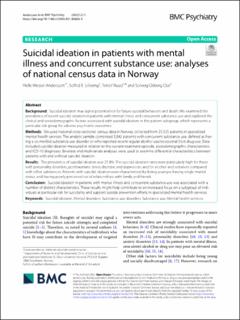| dc.contributor.author | Andersson, Helle Wessel | |
| dc.contributor.author | Lilleeng, Solfrid | |
| dc.contributor.author | Ruud, Torleif | |
| dc.contributor.author | Ose, Solveig Osborg | |
| dc.date.accessioned | 2023-03-02T16:25:49Z | |
| dc.date.available | 2023-03-02T16:25:49Z | |
| dc.date.created | 2022-05-09T14:38:05Z | |
| dc.date.issued | 2022 | |
| dc.identifier.citation | BMC Psychiatry. 2022, 22 (1), 1. | en_US |
| dc.identifier.issn | 1471-244X | |
| dc.identifier.uri | https://hdl.handle.net/11250/3055549 | |
| dc.description.abstract | Background: Suicidal ideation may signal potential risk for future suicidal behaviors and death. We examined the prevalence of recent suicidal ideation in patients with mental illness and concurrent substance use and explored the clinical and sociodemographic factors associated with suicidal ideation in this patient subgroup, which represents a particular risk group for adverse psychiatric outcomes.
Methods: We used national cross-sectional census data in Norway collected from 25,525 patients in specialized mental health services. The analytic sample comprised 3,842 patients with concurrent substance use, defined as having a co-morbid substance use disorder or who reported recent regular alcohol use/occasional illicit drug use. Data included suicidal ideation measured in relation to the current treatment episode, sociodemographic characteristics and ICD-10 diagnoses. Bivariate and multivariate analyses were used to examine differential characteristics between patients with and without suicidal ideation.
Results: The prevalence of suicidal ideation was 25.8%. The suicidal ideation rates were particularly high for those with personality disorders, posttraumatic stress disorder, and depression, and for alcohol and sedatives compared with other substances. Patients with suicidal ideation were characterized by being younger, having single marital status, and having poorly perceived social relationships with family and friends.
Conclusion: Suicidal ideation in patients with mental illness and concurrent substance use was associated with a number of distinct characteristics. These results might help contribute to an increased focus on a subgroup of individuals at particular risk for suicidality and support suicide prevention efforts in specialized mental health services. | en_US |
| dc.language.iso | eng | en_US |
| dc.publisher | BMC | en_US |
| dc.rights | Navngivelse 4.0 Internasjonal | * |
| dc.rights.uri | http://creativecommons.org/licenses/by/4.0/deed.no | * |
| dc.title | Suicidal ideation in patients with mental illness and concurrent substance use: analyses of national census data in Norway | en_US |
| dc.type | Peer reviewed | en_US |
| dc.type | Journal article | en_US |
| dc.description.version | publishedVersion | en_US |
| dc.rights.holder | © The Author(s) 2022. | en_US |
| dc.source.pagenumber | 9 | en_US |
| dc.source.volume | 22 | en_US |
| dc.source.journal | BMC Psychiatry | en_US |
| dc.source.issue | 1 | en_US |
| dc.identifier.doi | 10.1186/s12888-021-03663-8 | |
| dc.identifier.cristin | 2022782 | |
| dc.source.articlenumber | 1 | en_US |
| cristin.ispublished | true | |
| cristin.fulltext | original | |
| cristin.qualitycode | 2 | |

